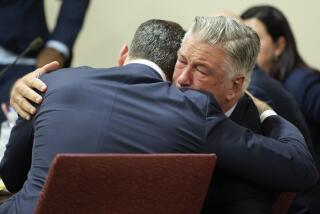Prosecutors say Durst murdered his best friend to cover his tracks for killing another woman: His wife
- Share via
As Los Angeles County prosecutors pieced together their murder case against Robert Durst — the eccentric New York real estate scion accused of killing his best friend Susan Berman in 2000 — they followed a path that led to the opposite coast and decades into the past.
Another devastated family. Another police investigation. Another woman close to Durst: his first wife, Kathleen, who disappeared in New York in 1982.
The fates of both women, prosecutors argue, are intrinsically connected. Their theory: Durst killed Berman to keep her from telling authorities what she knew about his involvement in his wife’s disappearance. Although her body has never been recovered, prosecutors — and Kathleen’s family — believe she was slain by her husband. Durst was never charged in connection with her disappearance.
A preliminary hearing to determine whether Durst will stand trial in Berman’s slaying is scheduled to begin Monday. Berman, an author and longtime confidant, was found dead in her Benedict Canyon home on Christmas Eve in 2000. Durst, 75, has denied killing either woman.
At the heart of the prosecution’s case — one that relies on circumstantial evidence — rests a haunting conclusion: that because Durst escaped justice in the New York slaying, he remained free to attack again. He went on to kill Berman, prosecutors say, and an elderly neighbor in Texas.
Deputy Dist. Atty. John Lewin described Durst as “a menace to society.”
But Durst’s defense team has emphasized that “it has never been determined that Kathie Durst was ‘murdered.’”
“Any suggestion to the contrary by the people,” the lawyers argued in a court filing, “is simply not supported by the record or evidence.”
Durst’s lead attorney, Dick DeGuerin, said he thinks his client was arrested “not because of facts” but because of “The Jinx,” a six-part HBO documentary about Durst for which he gave an extensive interview. During the final episode, the real estate magnate mutters, “What the hell did I do? Killed them all, of course.”
Some interpreted his comments, which were captured on a hot microphone, as a confession to killing Berman and his wife, as well as Morris Black, his Texas neighbor. Durst was arrested on a murder warrant for Berman’s death in New Orleans on March 14, 2015, a day before the finale aired.
“It’s not based on facts, it’s based on ratings,” said DeGuerin, who successfully defended Durst in the Texas case.
Like prosecutors, Kathleen’s sisters — Carol Bamonte, Virginia McKeon and Mary Hughes — speak about her with a certainty. To them, it’s not a question. Not a maybe.
“When she was murdered by Bob, that was a really rough time,” McKeon said in an interview last week. “The hole in the heart just never gets better. It’s just a sadness and an emptiness.”
By the time of her disappearance, the marriage between Kathleen — a 29-year-old medical student a few months shy of earning her degree — and Robert had deteriorated and Kathleen had started talking to a divorce lawyer.
The sisters try to focus on the lighter memories — on Kathleen’s peasant tops and her patchouli perfume. Her love of knowledge and the sound of her caroling during the holidays. They think about her fondness for children — the time she spent bonding with her nephew over science fair projects and the year she crocheted a Christmas dress for her goddaughter.
But they can’t help but think too, about their mother and how the loss wrecked her, or about some of their final conversations with Kathleen, ranting phone calls that signaled something was off.
And their frustration doesn’t stop with Durst.
Last year, the family filed a lawsuit against the New York Police Department, arguing that officers “failed to conduct a meaningful investigation” into Kathleen’s disappearance and let the case stagnate from the beginning.
The NYPD did not return a request for comment.
The family is grateful for the trial in Los Angeles and firmly believes prosecutors will prove Berman was killed because Durst wanted to cover up Kathleen’s killing, said Robert Abrams, whose firm, Abrams Fensterman, represents the family.
“The one lingering question will be why Robert Durst was never prosecuted in New York,” Abrams said. “We believe very strongly there was a massive cover-up to shield Robert Durst and others who were involved in Kathie’s disappearance and murder.”
Lawyers representing New York City filed a response characterizing the lawsuit as “sensational allegations,” and stating that the investigation into Kathleen’s disappearance remains open. Police are still following up leads, including one received in November, the lawyers wrote.
The effort by Los Angeles prosecutors to highlight Durst’s alleged past misconduct is not unusual, especially in cases that rely on circumstantial evidence, said Edward J. Imwinkelried, a professor emeritus at UC Davis who co-wrote the annotated California Evidence Code. Although the strategy carries some risk — a juror could view the allegations as “rumor and innuendo” — Imwinkelried said it can also help prosecutors prove motive.
But there’s another wrinkle: The murder trial in Texas.
Durst was tried in 2003 in connection with the death of Black, the neighbor who Durst met while living in Galveston. Durst had fled to the Texas town and disguised himself as a mute woman in an effort to escape media attention after New York authorities reopened an investigation into Kathleen’s disappearance. Durst admitted to shooting Black in self-defense during a violent struggle and to chopping up his body afterward.
The millionaire was acquitted in the Texas case, but Los Angeles prosecutors say they believe it was murder – not self-defense – and that they have evidence from the case that either wasn’t presented during the trial or could’ve been presented more persuasively. Durst’s defense team bristles at the claim, characterizing it as a clear-cut example of double jeopardy. (During the Texas trial, attorneys argued that Durst was in a traumatized state when he dismembered the body.)
Although prosecutors have occasionally mentioned the Texas case during hearings in Los Angeles over the last year, much of the testimony they’ve gathered focuses on Kathleen and the New York investigation into her disappearance, which prosecutors have argued was “incompetent.”
At one hearing last year, Michael Struk, the retired New York police detective who led the investigation, made a bombshell revelation: He’d had sex with a witness. He got a phone call from a witness asking him to search a location, he said, adding that when he arrived two people were present. One then left and the other — a woman who wasn’t identified — made a sexual advance.
“I went along,” Struk said, adding that he knew it was improper.
The detective also testified that he’d accepted Neil Diamond tickets from a witness and spent the night on the couch at the home of one of Kathleen’s friends, after attending a party where he’d hoped to gather information on the case.
Struk said in hindsight there were many things he wished had been done differently but largely defended the investigation. He said that although he eventually came to the conclusion that Durst killed his wife, it was a tough case because he believed she’d been killed outside the city and there was no actual crime scene within the NYPD’s jurisdiction.
Lewin asked Struk if he was reluctant to accept responsibility for mistakes in the investigation because he thought that if he’d done a better job Berman and Black would still be alive.
“I certainly sit here today and wish we had done other things,” he answered.
The prosecutor persisted, asking if he felt responsible for the deaths.
“No, sir,” Struk said.
DeGuerin has argued that the New York investigation was thorough and that his client wasn’t charged with a crime there because he’s innocent.
Other witnesses have testified about the tumultuous relationship between Kathleen and Robert Durst.
James Harney, a retired New York state trooper, testified that while investigating Kathleen’s missing person case in 1982, he spoke to a doctor at a Bronx hospital who told him that in the weeks before her disappearance, Kathleen was treated for “abrasions to the face,” adding that it had possibly been the result of an assault by her husband. No police report had been filed at the time, Harney noted.
The trooper said that when interviewed, Durst became “concerned that we knew about this incident.”
At another hearing, retired New York City Police Det. James Varian, who canvassed the couple’s apartment complex shortly after Kathleen vanished, testified that neighbors told him Kathleen feared her husband “wanted to kill her.”
The neighbors recounted an incident, Varian said, in which Kathleen begged to come inside their apartment, where she spent two hours sitting in the bathroom. Kathleen claimed her husband beat her and owned a gun, Varian said, relying on a report he wrote at the time.
Durst discussed the incident in audio commentary for “All Good Things,” a lightly fictionalized account of his life. He described the movie’s interpretation of the scene, which shows the character loosely based on Kathleen looking terrified as she knocks on the neighbors’ window, begging to come in, as “more or less accurate.”
“It was pouring and we were having a wrestling, shoving-type fight,” Durst recalled, adding that his wife told the neighbors she was afraid to come home.
Durst’s defense team has signaled they will challenge the admission of much of the testimony.
The preliminary hearing is expected to take two or three days, prosecutors said, but Durst will be in court all week, as the lawyers also plan to gather testimony from witnesses.
For more news from the Los Angeles County courts, follow me on Twitter: @marisagerber
More to Read
Sign up for Essential California
The most important California stories and recommendations in your inbox every morning.
You may occasionally receive promotional content from the Los Angeles Times.











